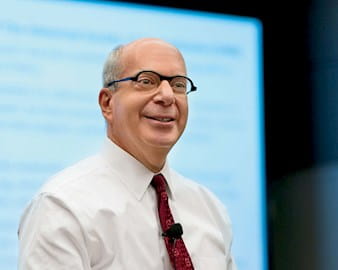
Alumni, students, and faculty at Booth are leveraging their finance skills to make a better world.
- By
- January 10, 2018
- Impact Investing

What is the purpose of investing? Until recently, the answer to that question was straightforward—to produce the highest possible return with the lowest possible risk for investors and shareholders.
Many believe that’s a worthy goal in itself. In fact, superior returns on investment help university endowments underwrite scholarships for needy students and enable state and local pension plans to fund the retirements of teachers, police officers, and firefighters.
But over the past several decades, a new way of thinking about investing has emerged in business schools and financial circles. It’s called impact investing. Although many argue it’s been around much longer, and the definition of the term continues to evolve, it largely means what it says. According to the Global Impact Investing Network (GIIN), it is investing “with the intention to generate social and environmental impact alongside a financial return.” Or, as a mantra commonly associated with the movement puts it: “Doing well by doing good.”
Institutions engaged in impact investing run the gamut from global banking giants to pension funds, foundations, nongovernmental organizations (NGOs), and family offices. Impact investments range from venture-capital-like equity to debt and loans.
According to the GIIN Seventh Annual Impact Investor Survey from 2017, impact investors planned to make 9,557 investments worth $25.9 billion in 2017, roughly double what they did in 2013. The 208 respondents currently manage $114 billion in impact investing assets, the survey reported.
“The [impact investing] industry will continue to grow as millennials become more socially conscious about how they’re investing their money.”
— Joshua Rogers
Impact investing appeals to a socially motivated generation of students and alumni who are passionate about blending their advanced financial and management skills with their commitment to improving people’s lives and the health of the planet. Jerry O’Brien, MBA ’94, CEO and CIO of O’Brien-Staley Partners, expanded into impact investing from his core roots as an alternative asset manager focused on credit strategies. He figured out how to incorporate social and environmental goals into his firm’s investing process for a new fixed income impact fund. Christina Hachikian, AB ’02, MBA ’07, adjunct associate professor of strategy, grappled with how impact investments could support the growth of the community-banking sector as a student at Booth. She later returned to the school as the first (and current) executive director of the Rustandy. The center’s Impact Investor in Residence Priya Parrish, ’09, invests both professionally and personally in funds and companies that have an impact and serves as a mentor to Booth students. Recent graduate Joshua Rogers, ’15, survived the financial crisis on Wall Street and now works for an impact investing firm, guiding entrepreneurs to produce better returns and achieve their social goals too.
“Impact investing is just increasing at a faster and faster pace,” said Rogers. “I think it’s a very promising career, and I think the industry will continue to grow as millennials become more socially conscious about how they’re investing their money.”
At Chicago Booth, the Rustandy Center is the hub for exactly those types of socially conscious students, alumni, faculty, and others committed to tackling social and environmental problems. The effort at Booth to focus business fundamentals and The Chicago Approach to management education on social sector innovation in large part began with one class taught in 2004 by Robert H. Gertner, Joel F. Gemunder Professor of Strategy and Finance and John Edwardson Faculty Director of the Rustandy Center for Social Sector Innovation.
It has since grown exponentially. A recent $20 million gift from alumnus Tandean Rustandy, ’07 (AXP-6), founder of Jakarta, Indonesia-based ceramic-tile maker PT Arwana Citramulia Tbk, reaffirms the place of the newly renamed Rustandy Center as Booth’s hub for academic research, innovative programs and events, and career support for students and alumni interested in social sector innovation.

Gertner taught his first Social Entrepreneurship class in 2004. By 2011, he had helped launch the New Social Ventures course. With support from John Edwardson, ’72, the class spawned the John Edwardson, ’72, Social New Venture Challenge (SNVC), where teams of students present business plans for a new venture (a nonprofit or a company) that has a social mission and shows a clear path to financial sustainability.
Meanwhile, Hachikian was growing restless in her banking role. While attending Booth a few years before, she had taken Social Entrepreneurship, frequently engaging Gertner in discussions about social investing, informed by her experiences at Chicago’s ShoreBank, a pioneering community lender.
But ShoreBank succumbed to the financial crisis and was shut down by regulators in 2010. Hachikian moved to a more traditional bank, but missed the social dimensions of her previous job. So she sent an email to Gertner, asking if he knew of any opportunities in social investing. He replied immediately, saying, yes, he did know of one possibility.
It was impeccable timing—or kismet. Booth’s former dean Sunil Kumar had just approved hiring a director of what was then called the Social Enterprise Initiative. Hachikian got the job. When she arrived in 2012, she immediately saw that things had changed.
“When I was in business school in the mid-2000s, if you were in a room full of MBA students, only a handful would be interested in impact,” Hachikian said. “By the time I came back to work here, five or six years later, the interest had just exploded.”
Not only had the number of impact-conscious students increased dramatically, but their interests also now ranged across issue areas—from education to conservation. Students were interested in careers with impact, but also in nonprofessional ways to give back. Today, student interest in noncareer avenues such as nonprofit board service is significant. The Board Fellows program—which allows students to serve as nonvoting nonprofit board members—receives applications from around 20 percent of first-year students in the Full-Time MBA Program.
As the appetite among students for learning about impact investing and social sector innovation more broadly has grown, so has the breadth of Booth’s offerings. Currently, Booth offers five courses on social sector innovation, including one specifically in impact investing.
For some Booth alumni, the path to impact investing becomes clear only well after they have completed their MBA studies. Since graduating from Booth in 1994, Jerry O’Brien has been recognized by institutional investors as a successful value investor. He started his career at Minneapolis-based CarVal Investors, which had been launched by Cargill, the agricultural giant perennially ranked by Forbes as the largest privately held company in the United States. Starting as a summer associate while still a Booth student, O’Brien worked at Cargill for 17 years and rose to head of global loan portfolios. At CarVal he successfully deployed more than $3 billion in specialized distressed (or what he calls “unloved”) credit and commercial and industrial loans. During his CarVal tenure, O’Brien is attributed with posting 46 consecutive profitable quarters, per information independently attested to by a leading accounting firm.
In 2010, he left CarVal to establish his own firm, Edina, Minnesota-based O’Brien-Staley Partners, along with Warren Staley, retired chairman and CEO of Cargill. Bolstered by O’Brien’s track record, the firm picked up where O’Brien left off at CarVal, raising nearly $1.1 billion in assets under management (AUM) from 25 institutional investors to deploy in value-oriented credit investing, specializing in senior secured debt.
At the same time, O’Brien served on boards and investment committees of nonprofits in the Twin Cities. He struggled with how to reconcile the investment committees’ rigorous investment analysis with the boards’ desire to achieve social goals that were in line with the nonprofits’ missions but proved much more difficult to measure. For years, O’Brien doubted that such “social” investments could jibe with his understanding of modern portfolio theory.
Then, about two or three years ago, he wandered into the annual conference of the impact investing trade group Mission Investors Exchange. At the conference, held in the Twin Cities that year, he was “blown away . . . by the sheer size of the audience,” O’Brien said. “The convention space was filled with foundations, endowments, religious organizations, and family offices, all wanting to make impact investments, but you know who wasn’t there? There were no institutional-quality asset management firms [at the event].” He said he loved the interest and the passion, but still couldn’t see how to make it profitable for investors. Then, one day, while walking his dog, he had a eureka moment.
“Instead of telling myself where good returns don’t come from, I asked... Where do good returns come from?”
— Jerry O’Brien
“I’m running it through my head, ‘You don’t. You can’t. I know the math; it can’t be done,’” he recalled. “At that point, I leaned upon my contrarian roots and inverted the question. Instead of telling myself where good returns don’t come from, I asked the opposite question: Where do good returns come from?” His answer is, “Good returns come from expertise and focus, where others face a constraint.”
This epiphany started O’Brien on a new road. He figured out how to make impact investing work. His firm launched a new, fixed income impact-oriented fund that aims to raise up to $500 million for the strategy from accredited investors.

His criteria are specific. “We want to find a situation where the banks don’t want to make an investment, so that we can make at least 100 basis points (1 percentage point) better than anyone would take a loan for,” he said. “And then we need to have a tangible, measurable impact on society, and in the case of economic-development loans, we want to create 182 jobs per $10 million of investment.”
O’Brien put these principles into practice in San Francisco. At 10th and Howard Streets, in the once-seedy but now trendy SoMa district, sits Saint Joseph’s Church, a landmark century- old building in the Romanesque Revival style that had been abandoned after sustaining extensive damage in the 1989 Loma Prieta earthquake. Anticipating that the neighborhood surrounding Saint Joseph’s will become hot—Twitter’s corporate headquarters is just blocks away—a developer proposed to preserve the church’s landmark features while converting the building into creative offices and a café.
“We’re earning a 7.7 percent return on a seven-year loan with a 54 percent LTV . . . and delivering measurable social impact.”
— Jerry O'Brien
O’Brien-Staley put up half the capital, $10 million in senior debt, while a bank and the developer chipped in the subordinated capital to earn tax incentives. When it’s completed, the rehabilitated building will create 150 new office jobs and 140 jobs in the café—20 new ones a year, for seven years, with the help of a local nonprofit. And O’Brien’s investors will do well too.
“We’re earning a 7.7 percent return on a seven-year loan with a 54 percent LTV. That’s about 300 basis points over comparable bank paper—and delivering measurable social impact,” he said.
Priya Parrish has been involved in impact investing for 13 years—like Hachikian, even before she attended Booth. As an undergraduate at Babson College, she launched six businesses and “grew interested in the intersection between business and society.” In fact, the converse of O’Brien, she began her career in impact investing, which led to a career in investing more generally. As chief investment officer of Schwartz Capital Group, a family office in Chicago, she manages an entire portfolio of private and public investments, mostly by traditional investment criteria.
For Parrish, a good impact investment merges the goals of traditional investing with social impact.
“I think of it in the same way as any other investment. I’m looking for sustainable business models, attractive industry dynamics, and the right team to execute the strategy. It’s anything you would look at in an early-stage company,” she explained.
Of course, there is an additional factor to consider, Parrish said: “What is the social or environmental issue they’re trying to tackle?” She tries to determine whether the proposed commercial solution will make a real dent in that problem and whether it would be done better by a private company or a nonprofit.
As the two Impact Investors in Residence at the Rustandy Center, Parrish and Brian Axelrad, ’09, counsel students interested in the field. (Whenever they’re on campus, office hours are fully booked, she said.) Parrish also conducts a new cocurricular seminar, Perspectives in Impact Investing, offered twice a month during Autumn Quarter at Booth.
Parrish also invests her own money in promising impact investments, such as ThinkCERCA, an educational-technology company based in Chicago. ThinkCERCA was founded by Eileen Murphy Buckley, an early-stage entrepreneur who was a longtime educator in the Chicago Public Schools.
Buckley’s original insight was that the key to narrowing the gap in educational achievement was to develop students’ critical-thinking skills through reading and writing. Her company creates software that helps students improve these skills, but relies on classroom teachers to push their students’ abilities to the next level. The approach fosters crucial buy-in from educators, a key constituency.
“If education itself is the master switch for solving every other problem, evidence-based argumentation is actually the master switch for education itself,” said Buckley.
Parrish was an angel investor in the company and has put money into subsequent rounds of financing. According to Parrish, it’s been difficult for investors to sort through the numerous ed-tech startups and identify those that will succeed. But ThinkCERCA got a shout-out from none other than Microsoft cofounder Bill Gates in his widely read blog, Gates Notes. In a research brief, LEAP Innovations—a Chicago-based nonprofit focused on educational innovation—stated that ThinkCERCA’s software had “a statistically significant, very large impact . . . equivalent to almost an extra year’s worth of growth, or closing the growth gap for low-income students three to four times over.”
ThinkCERCA just raised $10 million in its second round of financing. It doesn’t disclose financial results, but Buckley said its software is sold to school districts in 40 states. A recent strategic investment by Chinese educational giant TAL Education Group, whose stock trades on the New York Stock Exchange, gives ThinkCERCA access to that massive market too.
With encouraging impact investment examples such as ThinkCERCA and with the growth of the Rustandy Center, student interest in social sector innovation has been rising rapidly at Booth. Within that broader movement, a small but growing subset of students and recent alumni has begun to gravitate toward impact investment. Joshua Rogers, ’15, falls into that latter category. After graduating from Harvard and working in investment banking and security analysis at Zurich-based UBS and New York–based ISI Group (now Evercore ISI), Rogers came to Booth looking to move into impact investing. After graduation, he landed a job in the New York office of Advantage Capital, headquartered in New Orleans, an impact investing firm with about $1 billion in assets. At Advantage, Rogers helps to identify companies in which to invest and to shape the strategy of portfolio companies. (Learn more about Rogers’s impact investing journey in “An Investor on a Mission.")
“I think [young people] understand that [their] values can, and perhaps should, be expressed not just through how they vote and how they give away their dollars . . . but through everything they do.”
— Robert H. Gertner
Between 15 and 20 percent of first-year students in the Full-Time MBA Program express interest in careers in social impact, but only 2 percent of students enter a social impact role right out of school. “Many students cite lower salaries and concerns about repaying their debt load as barriers to accepting a job in the social sector. While it’s true that these are perhaps the most visible deterrents, they aren’t the only barriers. These jobs are hard to find and hard to land, and there is little transparency about what a ‘good’ social impact job looks like,” said Hachikian. “There’s a real opportunity to make more of these positions easier for all of our students to access.”
Indeed, the GIIN Survey indicated that impact investors plan to double their 2013 investment level to $25.9 billion in 2017, and as the investment level grows, so should the job opportunities. O’Brien-Staley Partners recently embarked on a recruiting trip to the nation’s top business schools, looking for—among other candidates—students with the talents necessary to make good impact investors. At O’Brien-Staley Partners’ visit to Booth, a significant number of students raised their hands when asked if they had a specific interest in impact investing.
Those raised hands support Gertner’s view that impact investing has already created a cultural change at Booth. With the establishment of the Rustandy Center, the social impact movement will only expand in the years and decades to come. Gertner connects the growing interest in impact, in large part, to the deeper motivations of millennials and the generations that follow. “I don’t know that young people have a different set of values,” he said. “But I think they understand that these values can, and perhaps should, be expressed not just through how they vote and how they give away their dollars, but through the jobs that they take, their careers, and the companies that they work for. Through everything they do.”
We'd love to hear your Booth memories, stories, connections...everything.